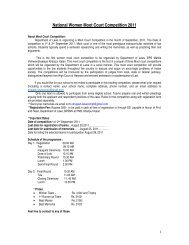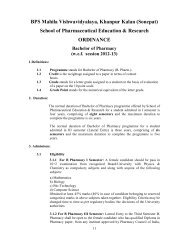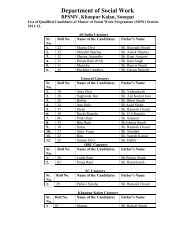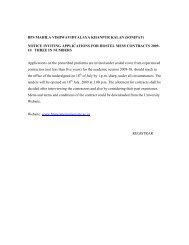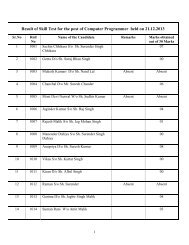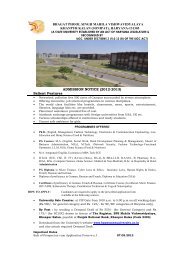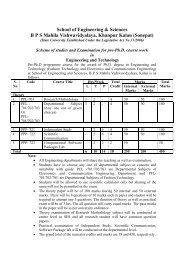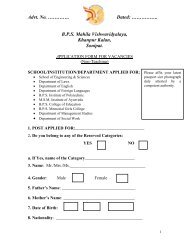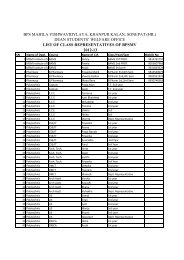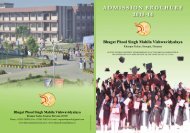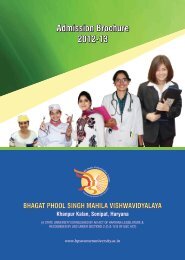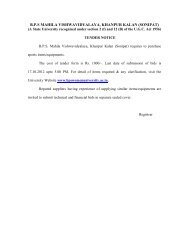revised mba scheme and syllabus passed by 6th ac
revised mba scheme and syllabus passed by 6th ac
revised mba scheme and syllabus passed by 6th ac
You also want an ePaper? Increase the reach of your titles
YUMPU automatically turns print PDFs into web optimized ePapers that Google loves.
5Course Credits : 4.5 External Marks: 50Internal Marks : 50Time: 3 HrsMANAGERIAL ECONOMICSPaper Code: SMS-102Objectives:The purpose of Managerial Economics is to apply a series of basic economics principlesto the decision making process within the firm. Issues related to optimal pricingstrategies, dem<strong>and</strong> forecasting, optimal financing, appropriate hiring decisions, <strong>and</strong>investment decisions, among others, can be successfully t<strong>ac</strong>kled with managerialeconomics tools.UNIT – 1Nature, scope <strong>and</strong> applications of managerial economics; alternative objectives ofbusiness firms; Dem<strong>and</strong> function; Law of dem<strong>and</strong>; Dem<strong>and</strong> elasticities; Dem<strong>and</strong>estimation <strong>and</strong> forecasting; consumer equilibrium-utility <strong>and</strong> indifference curveappro<strong>ac</strong>h; theory of consumer choice; Relationship between price elasticity <strong>and</strong> marginalrevenue.UNIT – IILaw of variable proportions; laws of return; Production function; Short-run analysis;long-run function; short-run <strong>and</strong> long-run cost function. Empirical estimation ofproduction <strong>and</strong> costs.UNIT – IIIPrice-output decisions, Market structures; Price decisions under perfect, imperfect;monopoly <strong>and</strong> duopoly; Pricing pr<strong>ac</strong>tices <strong>and</strong> strategies; measurement of profit <strong>and</strong> profitpolicy. Pricing of public utilities; Special pricing techniques-limit pricing, peak loudpricing <strong>and</strong> transfer pricing.UNIT – IVRisk analysis; Investment <strong>and</strong> capital repl<strong>ac</strong>ement decisions; locational choice of a firm.Measures of national income; Balance of payment <strong>and</strong> fiscal policies; inflation analysis.Suggested Readings:1. Hailstones, Thomas J. <strong>and</strong> Rathwell, John C., Managerial Economics, PrenticeHall International, New Delhi.2. Hirschey, Mark, Managerial Economics, Thomson learning,Bangalore.3. Keat, Paul B., <strong>and</strong> Philip K.Y.Young, Managerial Economics- Economics Toolsfor Today’s Decision Makers, Pearson Education, Delhi.4. Davis, J.R. <strong>and</strong> Chang, Simon, Principles of Managerial Economics, Prentice HallInternational, New Delhi.5. Petterson: Managerial Economics, 3 rd Ed., Prentice Hall of India, Delhi.Note: 1. Instruction for External Examiner: The question paper will have two sections.Section ‘A’ shall comprise of 7 small answer type question out of which 5 questions arecompulsory. Section ‘B’ will contain 8 question (2 questions from e<strong>ac</strong>h unit). Thestudents will be required to attempt four question (one question from e<strong>ac</strong>h unit)
6Course Credits : 4.5 External Marks: 50Internal Marks : 50Time: 3 HrsQUANTITATIVE METHODS FOR MANAGERIAL DECISIONPaper Code: SMS-103Course Objectives: The purpose of this course is to <strong>ac</strong>quaint the students with the broadframework of Quantitative Methods <strong>and</strong> decision-making in abusiness unit.UNIT-IRole of mathematics & Statistics in business decision: Introduction, use of statistics &material for decision making, importance of statistics in business <strong>and</strong> industry A.P. &G.P. <strong>and</strong> their managerial application, Matrices, Construction of frequency distribution<strong>and</strong> their analysis in the form of measure of central tendency <strong>and</strong> variations; types ofmeasures, their respective merits, limitations <strong>and</strong> char<strong>ac</strong>teristics; skewness: meaning <strong>and</strong>co-efficient of skewness.UNIT-IIProbability: Basic Concepts <strong>and</strong> appro<strong>ac</strong>hes, addition <strong>and</strong> multiplication, ProbabilityDistribution- Binomial, Possion, Normal Distributions.UNIT-IIISampling; Reason <strong>and</strong> methods of sampling, Techniques of Sampling, Test ofSignificance; Hypothesis testing; large samples small samples:UNIT-IVCorrelation analysis – meaning & types of correlation, Karl Pearson’s coefficient ofcorrelation <strong>and</strong> spearman’s rank correlation; regression analysis – meaning <strong>and</strong> two linesof regression; relationship between correlation <strong>and</strong> regression co-efficient. Time seriesanalysis-measurement of trend <strong>and</strong> seasonal variations ; time series <strong>and</strong> forecastingSuggested Readings1. Sharma, J.K. Business Statistics, Pearson Education,Delhi2. Srivastava, Statistics for Management, Tata M<strong>ac</strong>graw Hill, Delhi3. Khanna, Quantitive Techniques for Decisions, PHI Learning, Delhi4. Bali, N.P.Quantitative Techniques, Laxmi Pub., Delhi5. Ch<strong>and</strong>an, J.S. An Intro. To Statistical Methods, Vikas Pub. House, Delhi6. Bhardwaj, R.S. Business Statistics, S. Ch<strong>and</strong> & Co. Delhi.7. Gupta C.B. & Gupta,Vijay – Business Statistics S. Ch<strong>and</strong> & Co. Delhi.8. Kothari C.R. Quantitive Techniques, Vikas Publishing House, New Delhi.9. Hooda. R.P. Statistics for Business & Economics, M<strong>ac</strong>millan India Ltd.Note: 1. Instruction for External Examiner: The question paper will have two sections.Section ‘A’ shall comprise of 7 small answer type question out of which 5 questions arecompulsory. Section ‘B’ will contain 8 question (2 questions from e<strong>ac</strong>h unit). Thestudents will be required to attempt four question (one question from e<strong>ac</strong>h unit)
7Course Credits : 4.5 External Marks: 50Internal Marks : 50Time: 3 HrsACCOUNTING FOR MANAGERSPaper Code : SMS 104Objective:This course is an introduction to <strong>ac</strong>counting concepts <strong>and</strong> the operatingchar<strong>ac</strong>teristics of <strong>ac</strong>counting systems. With a focus on both financial <strong>and</strong> managerial<strong>ac</strong>counting, the course te<strong>ac</strong>hes students the basics of financial statements, how tointerpret these statements, <strong>and</strong> how to make good decisions based on them. It is designedfor the user of <strong>ac</strong>counting information <strong>and</strong> not as an introduction to a professional<strong>ac</strong>counting career.UNIT-IFinancial Accounting-Concept, importance <strong>and</strong> scope, <strong>ac</strong>counting principles, journal,ledger, trial balance, depreciation (Straight line <strong>and</strong> diminishing balance methods), <strong>and</strong>preparation of final <strong>ac</strong>counts with adjustment.UNIT-IIAnalysis <strong>and</strong> interpretation of financial statements- meaning, importance <strong>and</strong> techniques,ratio analysis; fund flow analysis; cash flow analysis.UNIT-IIICost <strong>ac</strong>counting- meaning, importance, methods, techniques; classification of cost sheet;inventory valuation; an elementary knowledge of <strong>ac</strong>tivity based costing.UNIT-IVManagement <strong>ac</strong>counting – concept, need importance <strong>and</strong> scope; Budgetary controlmeaningneed, objectives, essentials of budgeting, different types of budgets; st<strong>and</strong>ardcosting <strong>and</strong> variance analysis ( materials, labour); marginal costing <strong>and</strong> its application inmanagerial decision making.Suggested Readings:1. P<strong>and</strong>ey, I.M. Management Accounting, Vikas Publishing House, New Delhi.2. Mittal, S.N., Management Accounting <strong>and</strong> Financial Management, ShrreeMahavir Book Depot, New Delhi.3. Jain, S.P <strong>and</strong> Narang K.L., Advanced Cost Accounting , Kalayni Publishers,Ludhiana.4. Khan, M.Y. <strong>and</strong> Jain P.K. Management Accounting, TMH, New Delhi.Note: 1. Instruction for External Examiner: The question paper will have two sections.Section ‘A’ shall comprise of 7 small answer type question out of which 5 questions arecompulsory. Section ‘B’ will contain 8 question (2 questions from e<strong>ac</strong>h unit). Thestudents will be required to attempt four question (one question from e<strong>ac</strong>h unit)
8Course Credits : 4.5 External Marks: 50Internal Marks : 50Time: 3 HrsORGANISATIONAL BEHAVIOURPaper Code: SMS-105Objectives: This course aims to provide an introduction to the behaviour of peoplewithin organizations, <strong>and</strong> the behaviour of the whole organizations.UNIT- IFoundation <strong>and</strong> b<strong>ac</strong>kground of OB, contemporary challenges- workforce diversity, crossculturaldynamics, changing nature of managerial work, ethical issues at work, emotionalintelligence in contemporary business.UNIT-IIIndividual behaviour <strong>and</strong> processes: individual differences- values <strong>and</strong> attitudes;Perception- concept, process <strong>and</strong> application; Personality- concept, determinants <strong>and</strong>theories applications; Learning <strong>and</strong> Reinforcement, Stress- symptoms, causes,consequences <strong>and</strong> management.UNIT-IIIInterpersonal <strong>and</strong> team processes: group behaviour, group development, group dynamics,social loafing; developing teams- self directed work teams, virtual teams; team building;Empowerment- concept, significance, process, prerequisites, conflict- concepts, sources,types, management of conflict, Power- concept, sources, appro<strong>ac</strong>hes; organizationalpolitics.UNIT- IVOrganizational processes <strong>and</strong> structure: organizational structure <strong>and</strong> design, Work <strong>and</strong> jobdesign; organizational learning; organizational culture; organizational change <strong>and</strong>development.Suggested Reading:-1. Nelson, Debra L <strong>and</strong> James C Quick, Organisational Behaviour,Thomson Learning.2. Pareek, Udai, Underst<strong>and</strong>ing Organisational Behaviour, OxfordUniversity Press, Ne Delhi3. Robbins, S.P., Organisational Behaviour, Prentice Hall of India , NewDelhi4. Luthans, Fred, Organisational Behaviour, McGraw Hill, New York5. Hellgiegel, D& J.W. Slocum, Organisational Behaviour, ThomsonLearningNote: 1. Instruction for External Examiner: The question paper will have two sections.Section ‘A’ shall comprise of 7 small answer type question out of which 5 questions arecompulsory. Section ‘B’ will contain 8 question (2 questions from e<strong>ac</strong>h unit). Thestudents will be required to attempt four question (one question from e<strong>ac</strong>h unit)
9Course Credits : 4.5 External Pr<strong>ac</strong>tical Marks: 50Internal Marks : 50Time: 3 HrsCOMPUTER APPLICATION IN BUSINESSPaper Code: SMS-106Objective: Course objective is to inculcate the theoretical as well as pr<strong>ac</strong>tical knowledgeof computer applications in Business to enhance the working skill in an organization.UNIT-IComputer Organization: Introduction, components, classification, capabilitieschar<strong>ac</strong>teristics & limitation. Operating System ; Storage devices: Application ofComputer in Business, Computer Languages.UNIT-IIUse of MS-Office: Basics of MS-Word. MS-Excel <strong>and</strong> MS- Power Point; Applicatios indocumentation preparation <strong>and</strong> making reports; preparation of questionnaires,presentation, tables <strong>and</strong> graphs.UNIT-IIIInternet: Internetworking, concepts, Internet Protocol Addresses, WWW Pages &Browsing, Security, Internet Applications, Analog & Digital Signals, B<strong>and</strong>width,Natwork Topology, P<strong>ac</strong>ket Transmission, Long Distance communication, NetworkApplication. E-mail.UNIT-IVIntroduction to database: Concept, Char<strong>ac</strong>teristics, Objectives, Advantage & limitations,entity, attribute, schema, subschema.Lab: Operating Systems Comm<strong>and</strong>s, Internet Surfing, MS Office, MS Word, MS Excel,MS Power point.Suggested Readings:1. Leon & Leon, Introduction to Computers, Vikas Publishing House, New Delhi.2. Junne Jamrich Parsons, Computer Concepts 7 th Edition , Thomson Learning ,Bo<strong>mba</strong>y.3. Comer 4e, Computer networks <strong>and</strong> Internet, Pearson EducationNote: 1. Instruction for External Examiner: The question paper will have two sections.Section ‘A’ shall comprise of 7 small answer type question out of which 5 questions arecompulsory. Section ‘B’ will contain 8 question (2 questions from e<strong>ac</strong>h unit). Thestudents will be required to attempt four question (one question from e<strong>ac</strong>h unit)
10Course Credits : 4.5 External Pr<strong>ac</strong>tical Marks: 50Internal Marks : 50Time: 3 HrsBUSINESS COMMUNICATION AND SKILLS DEVELOPMENTPaper Code: SMS-107Objective: This course will provide with pr<strong>ac</strong>tice in occupational writing, bothcorrespondence <strong>and</strong> reports. It will enhance the business communication skills to improvethe overall personality in the private world.UNIT-IPurpose <strong>and</strong> process of communication; myths <strong>and</strong> realities of communication; paths ofcommunication; oral communication: noise, barriers to communication; listeninglisteningprocess, types of listening, deterrents to listening process, essentials of goodlistening; telephonic communication.UNIT-IIPresentation skills: preequisites of effective presentation; Assertiveness- indicators ofassertive behaviour, stratedies of assertivs behaviour; communication skills for groupdiscussion <strong>and</strong> interviews.UNIT-IIINon verbal communication: gestures, h<strong>and</strong>shakes, gazes, smiles, h<strong>and</strong> movement, stylesof working, voices modulations, body sport for interviews; business etiquettes: businessdining, business manners of people of different cultures, managing customer care.UNIT-IVWritten communication: mechanics of writing ,report writing, circulars, notices, memos,agenda <strong>and</strong> minutes; business correspondence- business letter format, styles of letterarrangement, types of letters, telex manages, f<strong>ac</strong>similes, electronic mail; dairy writing;developing resumes.Suggested Reading:1. Kaul,Asha, Business Communication, PHI, New Delhi2. Kaul,Asha, Effective Business Communication, PHI, New Delhi3. Chaturvedi,P.D., <strong>and</strong> Mukesh Chaturvedi, Business Communication, PearsonEduction4. McGrath,E.H., Basic Managerial Skills for All, PHI, New DelhiNote: 1. Instruction for External Examiner: The question paper will have two sections.Section ‘A’ shall comprise of 7 small answer type question out of which 5 questions arecompulsory. Section ‘B’ will contain 8 question (2 questions from e<strong>ac</strong>h unit). Thestudents will be required to attempt four question (one question from e<strong>ac</strong>h unit)
11Course Credits : 4.5 External Pr<strong>ac</strong>tical Marks: 50Internal Marks : 50Time: 3 HrsMARKETING MANAGEMENTPaper code: SMS-201Objectives: The purpose of this course is to develop an underst<strong>and</strong>ing of theunderlying concepts, strategies <strong>and</strong> issues involved in the marketing ofproducts <strong>and</strong> services.Course ContentsUnit-1Nature, scope <strong>and</strong> concept of marketing, corporate orientations towards the marketpl<strong>ac</strong>e;building <strong>and</strong> delivering customer value <strong>and</strong> satisf<strong>ac</strong>tion: retailing customers: Marketingenvironment <strong>and</strong> Environment scanning; Marketing information system <strong>and</strong> MarketingresearchUnit-IIUnderst<strong>and</strong>ing consumer <strong>and</strong> Industrial markets; Market segmentation, Targeting <strong>and</strong>positioning; tools of product differentiation: marketing strategies in the different stagesof the product life cycleUnit-IIINew product development process, product mix <strong>and</strong> product line decisions; br<strong>and</strong>ing <strong>and</strong>p<strong>ac</strong>kaging decisions; Pricing methods <strong>and</strong> strategies; managing marketing channels;wholesaling <strong>and</strong> retailingUnit-IVAdvertising <strong>and</strong> sales promotion; public relations; personal selling; evaluation <strong>and</strong>control of marketing effort; web marketing; Ethics in Marketing; New issues inmarketing- Globalization, Consumerism, Green marketing, Direct Marketing, NetworkMarketing, Event Marketing, Cyber Marketing.Suggested Readings1. Kotler, Philip <strong>and</strong> Armstrong, G. Principles of Marketing. New Delhi, Prentice Hallof India, 20022. Kotler Philip. Marketing Management, 11 th Edition, New Delhi, Prentice Hall ofIndia, 2002.3. Perreault, William D. <strong>and</strong> McCarthy, Jr. E. Jerome, Basic Marketing, 14 edition,TMH, 2002.4. Rajan Saxena, Marketing Management, 2 nd edition, Tata McGraw Hill, 2002.5. Czinkota & Kotabe, Marketing Management, Vikas Publishing, New Delhi.Note: 1. Instruction for External Examiner: The question paper will have two sections.Section ‘A’ shall comprise of 7 small answer type question out of which 5 questions arecompulsory. Section ‘B’ will contain 8 question (2 questions from e<strong>ac</strong>h unit). Thestudents will be required to attempt four question (one question from e<strong>ac</strong>h unit)
12Course Credits : 4.5 External Marks: 50Internal Marks : 50Time: 3 HrsHUMAN RESOURCE MANAGEMENTPaper Code: SMS-202Course Objective:The objective of this course is to sensitize students to the various f<strong>ac</strong>ets of managingpeople <strong>and</strong> to create an underst<strong>and</strong>ing of the various policies <strong>and</strong> pr<strong>ac</strong>tices of humanresource managementUnit IStrategic importance of HRM; objectives of HRM; challenges to HR professionals; role,responsibilities <strong>and</strong> competencies of HR professionals; HR department operations; humanresource planning—objectives <strong>and</strong> process; human resource information systemUnit IITalent <strong>ac</strong>quisition: recruitment <strong>and</strong> selection strategies, career planning <strong>and</strong> management,succession planning, socialization <strong>and</strong> induction of new employees; training <strong>and</strong>development, investment in training, training need assessment, designing <strong>and</strong>administering training programme; executive development programme, evaluation of T &D programme .Unit IIIAppraising performance: development <strong>and</strong> instituting performance appraisal system,assessment <strong>and</strong> development centres, potential appraisal; rewarding performance: linkingrewards to organizational objectives, determine compensation structure, pay forperformance <strong>and</strong> incentive plans, ESOP. Executive compensation, designing <strong>and</strong>administering benefits <strong>and</strong> services.Unit IVHR in knowledge era: HR in knowledge industry, HR in virtual organizations, HR inmergers <strong>and</strong> <strong>ac</strong>quisitions, outpl<strong>ac</strong>ement, outsourcing HR functions, employee leasing, HRaudit, international HRMSuggested Readings1. Aswathappa, K., Human Resource <strong>and</strong> Personnel Management Tata Mc Graw Hill,New Delhi, 1997.2. De Cenzo, D A & Robbins S P., Human Resource Management. 5th ed., New York,John Wiley, 1994.3. Holloway, J. Ed. Performance Measurement <strong>and</strong> Evaluation. New Delhi, Sage,1995.4. Monappa, A & Saiyadain M. Personnel Management. 2nd, New Delhi, TataMcGraw-Hill, New Delhi, 1966.Note: 1. Instruction for External Examiner: The question paper will have two sections.Section ‘A’ shall comprise of 7 small answer type question out of which 5 questions arecompulsory. Section ‘B’ will contain 8 question (2 questions from e<strong>ac</strong>h unit). Thestudents will be required to attempt four question (one question from e<strong>ac</strong>h unit)
13Course Credits : 4.5 External Marks: 50Internal Marks : 50Time: 3 HrsFINANCIAL MANAGEMENTPaper Code: SMS-203Objectives:The purpose of this course is to <strong>ac</strong>quaint the students with the broad framework offinancial decision-making in a business unit.Unit IFinancial management-scope finance functions <strong>and</strong> its organization, objectivesof financial management; time value of money; sources of long term finance.Unit IIInvestment decision importance, difficulties cash flows, methods of capital budgeting;risk analysis; cost of different sources of raising capital; weighted average cost of capital.Unit IIICapital structure decisions- financial <strong>and</strong> operating leverage; capital structure theories-NI, NOI, traditional <strong>and</strong> M-M Theories; determinants of dividend policy <strong>and</strong> dividendmodels- Walter, Gordon & M.M. modelsUnit IVWorking capital- meaning, need, determinants; estimation of working capital need;management of cash, inventory <strong>and</strong> receivables.Suggested Readings:1. Hampton, John. Financial Decision Making. Englewood Cliffs, New Jersey, PrenticeHall Inc., 1997.2. Khan, M.Y <strong>and</strong> Jain, P.K. Financial Management, McGraw Hill, 2001.3. Prasanna Ch<strong>and</strong>ra, Financial Management, McGraw Hill, 2002.4. P<strong>and</strong>ey, l.M. Financial Management, Vjkas Publication House, 2000.5. Van Horne. James C. Financial Management ~nd Policy. 10th. ed., New Delhi,Prentice Hall of India, 1997.6. Winger, Bernard <strong>and</strong> Mohan, Nancy. Principles of Financial Management. NewYork. M<strong>ac</strong>millan Publishing Company, 1991.Note: 1. Instruction for External Examiner: The question paper will have two sections.Section ‘A’ shall comprise of 7 small answer type question out of which 5 questions arecompulsory. Section ‘B’ will contain 8 question (2 questions from e<strong>ac</strong>h unit). Thestudents will be required to attempt four question (one question from e<strong>ac</strong>h unit)
14Course Credits : 4.5 External Marks: 50Internal Marks : 50Time: 3 HrsMANAGEMENT SCIENCEPaper Code: SMS-204Course Objectives: The purpose of this course is to <strong>ac</strong>quaint the students with the broadframework of Management Science <strong>and</strong> decision-making in abusiness unit.Unit IOperation Research : Evolution, methodology <strong>and</strong> role in managerial decision making ;Linear programming: Meaning, assumptions, advantages, scope <strong>and</strong> limitation ;Formulation of problem <strong>and</strong> its solution <strong>by</strong> graphical <strong>and</strong> simplex methods special casesin simplex methods: infeasibility, degener<strong>ac</strong>y, unboundedness <strong>and</strong> optimal solution ;duality.Unit-IITransportation problems including transhipment problems; Special cases intransportation problems: unbalanced problems, degener<strong>ac</strong>y, maximization objective <strong>and</strong>multiple optimal solutions; assignment problems including travelling salesman’sproblem. Special cases in assignment problems: unbalanced problems, maximisationobjectives <strong>and</strong> multiple optional solutions.Unit-IIIPERT/CPM: Difference between PERT <strong>and</strong> CPM, network construction, calculatingEST, EFT, LST, LFT <strong>and</strong> floats. Decision theory: decision making under uncertainty <strong>and</strong>risk, Bayesian analysis, decision trees.Unit-IVGame theory, pure <strong>and</strong> mixed strategy games; principle of dominance; two person zerosum game; Queuing theory: concept, assumptions <strong>and</strong> applications; analysis of queuesystem, Position distributed arrivals; Simulation; meaning, process, advantages,limitations <strong>and</strong> applicationsSuggested Readings1 Paneerselvam, Operations Research, PHI, New Delhi .2 Taha, Operations Research: An introduction,PHI, New Delhi.3 Vohra, N.D.;Quantitative Techniques in Management; Tata McGraw HillPub. Co. Ltd. New Delhi.4 Kapoor, V.K., Operations Research; Sultan Ch<strong>and</strong> & Sons, New Delhi.5 Sharma, J.K., Operations Research: Theory <strong>and</strong> applications, M<strong>ac</strong>millan.Note: 1. Instruction for External Examiner: The question paper will have two sections.Section ‘A’ shall comprise of 7 small answer type question out of which 5 questions arecompulsory. Section ‘B’ will contain 8 question (2 questions from e<strong>ac</strong>h unit). Thestudents will be required to attempt four question (one question from e<strong>ac</strong>h unit)
15Course Credits : 4.5 External Marks: 50Internal Marks : 50Time: 3 HrsBUSINESS RESEARCH METHODSPaper Code: SMS-205Course Objectives: The purpose of this course is to impart knowledge about variousstages of research processes <strong>and</strong> their application in decisionmakingUnit INature, scope <strong>and</strong> need of business; managerial value of business: components of theory– concepts, constructs, variables, definitions <strong>and</strong> hypothesis; the process of research:structure of research proposal.Unit IIResearch design concept <strong>and</strong> types; Validity <strong>and</strong> reliability aspects; sampling dsigntechniques; f<strong>ac</strong>tors influencing sample size; nature of measurement; char<strong>ac</strong>teristics ofsound measurement; nature of measurement scales: scale construction techniques:sources <strong>and</strong> methods of data collection; questionnaire designing.Unit IIIData preparation <strong>and</strong> descriptive analysis; hypothesis testing; parametric <strong>and</strong> nonparametric(analysis of variance, sign test, the mann-Whitney U-Test, kruskel _ Wallis H-test); computer program for analysis.Unit IVNature of multivariate analysis; dependence methods - multiple regression, discriminateanalysis, MANOVA, LISREL, conjoint analysis; interdependent methods – f<strong>ac</strong>toranalysis, cluster analysis <strong>and</strong> multi dimensional scaling: ingredients of formal reports;construction of formal reports; nature of oral reports; mechanism of documentation <strong>and</strong>bibliography construction.SUGGESTED READINGS:1 Zikmund, Millian G., Business Research Methods , Thomson learning ,Bo<strong>mba</strong>y2 Cooper, Donald R- <strong>and</strong> Pamels schindler, Business Research Methods, TataMcGraw Hills, New Delhi.3 Geode, Millian J. & Paul K. Hatl, Methods in Research , Tata McGraw Hills,New Delhi.4 Shekhran, Uma, Business Research Methods, Wiley Education, Singapore5 Kothari, C.R., Research Methodology.Note: 1. Instruction for External Examiner: The question paper will have two sections.Section ‘A’ shall comprise of 7 small answer type question out of which 5 questions arecompulsory. Section ‘B’ will contain 8 question (2 questions from e<strong>ac</strong>h unit). Thestudents will be required to attempt four question (one question from e<strong>ac</strong>h unit)
16Course Credits : 4.5 External Marks: 50Internal Marks : 50Time: 3 HrsBUSINESS ENVIRONMENTPaper Code: SMS-206Course Objectives: The purpose of this course is to sensitize the students towards theoverall business environment within which organisation has tofunction <strong>and</strong> to provide insight to students of its implication fordecision making in business organisation.Unit INature <strong>and</strong> structure of business environment; m<strong>ac</strong>ro <strong>and</strong> micro indicators; assessing riskin business environment; emerging sectors of Indian Economy; relative size <strong>and</strong> growthof public <strong>and</strong> private sectors.Unit IIDesign <strong>and</strong> strategy of economic reforms; current state of growth <strong>and</strong> investment; interestrate structure <strong>and</strong> present monetary policy; fiscal environment; current inflationaryposition <strong>and</strong> its imp<strong>ac</strong>t on business sector; competitive environment; legislation for anticompetitive<strong>and</strong> unfair trade pr<strong>ac</strong>tices; consumer <strong>and</strong> investor protection.Unit IIICurrent industrialization trends <strong>and</strong> industrial policy; environment for SME sector;infrastructure development <strong>and</strong> policy; public sector reforms <strong>and</strong> performance; publicprivatepartnership; intellectual property regime <strong>and</strong> the R&D environment; trends inservice sector growth; banking reforms <strong>and</strong> challenges.Unit IVGlobalisation trends <strong>and</strong> challenges; balance of payments trends; environment for foreigntrade <strong>and</strong> investment; exchange rate movements <strong>and</strong> their imp<strong>ac</strong>t; India’s competitivenessin the world economy; External influences on India’s business environmentSUGGESTED READINGS:1 Acharaya, Shankar, India M<strong>ac</strong>roeconomic management in the Nineties, ICRIER,New Delhi.2 Ahluwalia,I.J. <strong>and</strong> IMD Little, India’s Economic reforms <strong>and</strong> Development,Oxford University Press, Delhi.3 Datt, R., Second Generation Economic Reforms in India, Deeep <strong>and</strong> Deep, NewDelhi.4 Khan, M.Y. Indian Financial System, Tata McGraw Hill, New Delhi.Note: 1. Instruction for External Examiner: The question paper will have two sections.Section ‘A’ shall comprise of 7 small answer type question out of which 5 questions arecompulsory. Section ‘B’ will contain 8 question (2 questions from e<strong>ac</strong>h unit). Thestudents will be required to attempt four question (one question from e<strong>ac</strong>h unit)
17Course Credits : 4.5 External Pr<strong>ac</strong>tical Marks: 50Internal Marks : 50Time: 3 HrsCOMPUTER NETWORKPaper Code: SMS-207Course Objectives: The purpose of this course is to sensitize the students withtechnologies like networking <strong>and</strong> internet <strong>and</strong> to build skills in applying thesetechnologies to various business processes.Unit IIntroduction to Internet: Definition of networks, concepts of web page, website <strong>and</strong> websearching. Concepts of data transmission, half-duplex transmission, modems, clientserver computing, Introduction to OSI, TCP/IP reference models, cryptography.Unit IINetworked economy; Imp<strong>ac</strong>t of computer networks on business, elements of networkedeconomy, using IS Functions to deal with business risks. Infrastructure of networkedeconomy; Hardware, software, sharing information <strong>and</strong> resources through networks,LAN WAN, <strong>and</strong> wireless networks,Unit IIIPriv<strong>ac</strong>y <strong>and</strong> ethical issues in networked economy; treats to priv<strong>ac</strong>y, protecting priv<strong>ac</strong>y ,ethical issues in networked economy, social <strong>and</strong> economic issues in networked economy,health issues in networked economy, future of the networked economy.Unit IVHTML: Build a simple HTML document, tables, frames, links, adding multimediadocuments, home page. Applications of networks in information sharing <strong>and</strong>dissemination: application in banking, E-Goverence, ticket reservation etc.Lab: WebDesigning in HTML, Internet Surfing.Suggested Readings1 McKeown, Information Technology <strong>and</strong> the Networked Economy, ThomsonLearning.2 Forouzan, Data Communication & Networking, TMH, Delhi.3 Miller, Data <strong>and</strong> Network communication, Vikas Publication House, NewDelhi4 Tannenbaum, Computer Networks, PHI, Delhi.5 Hagg, Baltzan & Philips,Business Driven technology,TMH,N.DelhiNote: 1. Instruction for External Examiner: The question paper will have two sections.Section ‘A’ shall comprise of 7 small answer type question out of which 5 questions arecompulsory. Section ‘B’ will contain 8 question (2 questions from e<strong>ac</strong>h unit). Thestudents will be required to attempt four question (one question from e<strong>ac</strong>h unit)
18Course Credits : 4.5 External Marks: 50Internal Marks : 50Time: 3 HrsBUSINESS POLICY <strong>and</strong> STRATEGIC MANAGEMENTPAPER CODE: SMS-301 (Compulsory)COURSE OBJECTIVE:The objective of the course is to develop a holistic perspective of an organization <strong>and</strong> toenable the students to analyse the strategic situation f<strong>ac</strong>ing the organization, to <strong>ac</strong>cessstrategic options available to the organization <strong>and</strong> to implement the strategic choicesmade <strong>by</strong> it.Unit-IStrategic Management Process: defining strategy, levels of appro<strong>ac</strong>hes to strategicdecision making, process of strategic management, roles of strategies, mission <strong>and</strong>objectives, strategic business unit, environment - concept, components <strong>and</strong> appraisalUnit-IIOrganization appraisal <strong>and</strong> strategy formulation: organizational dynamics <strong>and</strong> structuringorganizational appraisal, SWOT analysis formulation - corporate level strategies <strong>and</strong>business strategies, strategy analysis <strong>and</strong> choice - the process, BCG matrix, GE matrix,SPACE appro<strong>ac</strong>h, QSP matrix <strong>and</strong> strategic planUnit-IllStrategy implementation: aspects, structures, design <strong>and</strong> change; behaviouralimplementation - leadership, culture, value <strong>and</strong> ethicsUnit-IVFunctional implementation: functional strategies, plans <strong>and</strong> policies; marketing; financial,personal, operations, its plans <strong>and</strong> policies; strategic evaluation <strong>and</strong> control - an overviewof strategic evaluation <strong>and</strong> control, techniques of strategic evaluation <strong>and</strong> controlSuggested Readings:1. Kazmi, Azhar, Business Policy <strong>and</strong> Strategic Management, Tata McGraw HillPublishing Company Ltd., New Delhi2. David, Fred R. Strategic Management - Concept <strong>and</strong> Cases, Pearson Education,Delhi3. Hitt, M.A., Irel<strong>and</strong> R.D. <strong>and</strong> Hos Kisson R.D., Strategic ManagementCompetitiveness <strong>and</strong> Globalisation; Thomson Asia Pvt. Ltd.4. Pearce II J A <strong>and</strong> Robinson Jr., R.B., Strategic Management - StrategyFormulation <strong>and</strong> Implementation, AITBS Publishers <strong>and</strong> Distributors, DNote: 1. Instruction for External Examiner: The question paper will have two sections.Section ‘A’ shall comprise of 7 small answer type question out of which 5 questions arecompulsory. Section ‘B’ will contain 8 question (2 questions from e<strong>ac</strong>h unit). Thestudents will be required to attempt four question (one question from e<strong>ac</strong>h unit)
19Course Credits : 4.5 External Marks: 50Internal Marks : 50Time: 3 HrsMANAGEMENT INFORMATION SYSTEMPAPER CODE: SMS-302 (Compulsory)COURSE OBJECTIVE:This course will equip students with skills to analysis information requirements formanagerial decision making.Unit-IData <strong>and</strong> Information. MIS- need <strong>and</strong> concepts, f<strong>ac</strong>tors influencing MIS <strong>and</strong>char<strong>ac</strong>teristics of MIS. Technology of MIS. Structure of MIS. Decision Making <strong>and</strong>role of MIS. Data communication. Basic H/W required, Channel features <strong>and</strong> conceptof Distributed Data basesDecision Support System: Overview, components <strong>and</strong> classification, steps inconstructing a DSS, role in business, group decision support systemUnit-IIInformation system for strategic advantage, strategic role for information system,breaking business barriers, business process reengineering, improving businessqualities.Unit-IllPlanning for MIS; System Development Methodologies; Conceptual <strong>and</strong> detaileddesigns of MIS. Information system analysis <strong>and</strong> design, information SDLC, hardware<strong>and</strong> software <strong>ac</strong>quisition, system testing, documentation <strong>and</strong> its tools, conversionmethods.Unit-IVSystem implementation Strategies <strong>and</strong> process; System Evaluation <strong>and</strong> Maintenance.Applications -cross -functional MIWS; ERP; CRM; SCM; Trans<strong>ac</strong>tion Processing;Artificial Intelligence technologies in business: neural network, fuzzy logic, virtualreality; Executive information system.Suggested Readings :1. Jawadekar, Management Information Systems, TMH, N Delhi.2. Brien, James, Management Information System, Tata McGraw Hill, Delhi.3. Stair, Principles of Management System, Thomson Learning, Bo<strong>mba</strong>y.4. Mckeown, Information Technology <strong>and</strong> the Networked Economy,Thomson Learning, Bo<strong>mba</strong>y.5. Brady, Cases in MIS, Thomson Learning, Bo<strong>mba</strong>y.6. Murdick & Ross, Management Information System, PHI, Delhi.Note: 1. Instruction for External Examiner: The question paper will have two sections.Section ‘A’ shall comprise of 7 small answer type question out of which 5 questions arecompulsory. Section ‘B’ will contain 8 question (2 questions from e<strong>ac</strong>h unit). Thestudents will be required to attempt four question (one question from e<strong>ac</strong>h unit)
20Course Credits : 4.5 External Marks: 50Internal Marks : 50Time: 3 HrsCOURSE OBJECTIVE:BUSINESS LEGISLATIONPAPER CODE: SMS-303(Compulsory)The course is designed to provide an underst<strong>and</strong>ing of legal processes involved inmanagement of an organization. The main focus is on underst<strong>and</strong>ing basic laws affectingthe operation of a Business EnterpriseUnit-IThe Indian Contr<strong>ac</strong>t Act: Essentials of a valid contr<strong>ac</strong>t, void agreements, performance ofcontr<strong>ac</strong>ts, bre<strong>ac</strong>h of contr<strong>ac</strong>t <strong>and</strong> its remedies, Quasi-Contr<strong>ac</strong>tsUnit-IIThe Sale of Goods Act: Contr<strong>ac</strong>t of sale of goods, conditions <strong>and</strong> warranties, transfer ofproperty, rights of an unpaid seller; the negotiable instruments <strong>ac</strong>t: nature <strong>and</strong> types;negotiation <strong>and</strong> assignment; holder-indue cours e, dishonour <strong>and</strong> discharge of anegotiable instrument, arbitrationUnit-IIIThe Companies Act, 1956: Nature <strong>and</strong> types of companies; formation; memor<strong>and</strong>um <strong>and</strong>articles of association; prospectus, shares <strong>and</strong> share capital, allotment of sharesUnit-IVMembership; borrowing powers; management <strong>and</strong> meetings; <strong>ac</strong>counts <strong>and</strong> audit;compromise arrangements <strong>and</strong> reconstruction; prevention of oppression <strong>and</strong>mismanagement; winding up; Consumer Protection Act <strong>and</strong> Cyber LawSuggested Readings:1. Kuchhal, M.C. <strong>and</strong> Deepa Parkash, Business Legislation Management, VikasPublishing House Pvt. Ltd.2. Khergamwala, J.S., The Negotiable Instrument Acts, N.M. Tripathi, Bo<strong>mba</strong>y,19803. Ramaiyam, A., Guide to the Companies Act, Wadhwa, Nagpur, 19924. Shah, S.M., Business Law for Managers, Sultan Ch<strong>and</strong>, New Delhi, 19985. Tulisian P.C., Busienss Law, TMH, New DelhiNote: 1. Instruction for External Examiner: The question paper will have two sections.Section ‘A’ shall comprise of 7 small answer type question out of which 5 questions arecompulsory. Section ‘B’ will contain 8 question (2 questions from e<strong>ac</strong>h unit). Thestudents will be required to attempt four question (one question from e<strong>ac</strong>h unit)
21Course Credits : 4.5 External Marks: 50Internal Marks : 50Time: 3 HrsCOURSE OBJECTIVE:TRAINING AND DEVELOPMENTPAPER CODE: SMS-304 (Optional-HR)This course is designed to provide in depth underst<strong>and</strong>ing <strong>and</strong> enable the students tomanage training processes <strong>and</strong> system for developing human resource of the organizationUnit-ITraining - concept, <strong>and</strong> rationale; training process: role of stakeholders in trainingprogramme; Organization <strong>and</strong> Management of training function; Training needsassessment - organizational analysis, operational analysis, person analysis; competencymappingUnit-IIDesigning the training programme: process of barning in training programme - attributes<strong>and</strong> f<strong>ac</strong>tors influencing; learning process; learning styles; training climate <strong>and</strong> pedagogy;developing training modules; Training aidsUnit-IllTraining methods <strong>and</strong> techniques - role playing, business games, in basket exercises,laboratory training; incidents <strong>and</strong> cases; seminars, syndicates <strong>and</strong> group discussion;lecture, programmed instructions; inspirational techniques - brainstorming, mindmapping, creative problem solvingUnit-IVEvaluation of training - need for evaluation, principles of evaluation, criteria <strong>and</strong>appro<strong>ac</strong>hes; return on investment in training, process of calculating ROI in training;emerging trends in training <strong>and</strong> development; new perspectives on training - cross culturaltraining, e-learning, knowledge managementSuggested Readings:1. Agochia, Devendra, Every Trainer's H<strong>and</strong>book, New Delhi; SagePublications2. De Simone, R.L. <strong>and</strong> Harris, D.M., Human Resource Management, ThomsonLearning, Bo<strong>mba</strong>y3. Sahu, R.K., Training for Development, Excel Books, New Delhi4. Blanchard, P Nick, <strong>and</strong> James W. Th<strong>ac</strong>ker, Effective Training - Systems,Strategies, <strong>and</strong> Pr<strong>ac</strong>tices, Pearson Education, New Delhi5. Goldstein, Training in Organization, Thomson Learning, Bo<strong>mba</strong>yNote: 1. Instruction for External Examiner: The question paper will have two sections.Section ‘A’ shall comprise of 7 small answer type question out of which 5 questions arecompulsory. Section ‘B’ will contain 8 question (2 questions from e<strong>ac</strong>h unit). Thestudents will be required to attempt four question (one question from e<strong>ac</strong>h unit)
22Course Credits : 4.5 External Marks: 50Internal Marks : 50Time: 3 HrsCOMPENSATION MANAGEMENTPAPER CODE: SMS-305(Optional-HR)COURSE OBJECTIVE:This course is designed to promote underst<strong>and</strong>ing issues related to compensation incorporate sector <strong>and</strong> impart skills in designing, analysis <strong>and</strong> restructure compensationmanagement system, policies <strong>and</strong> strategiesUnit-IRole of compensation in organization: economic <strong>and</strong> behavioural theories related tocompensation; strategic perspectives of compensation; compensation as motivationaltool; compensation policyUnit-IIInternal <strong>and</strong> external equities in compensation system; determining the worth of jobs;underst<strong>and</strong>ing inter <strong>and</strong> intra-industry compensation differentials, designing pay structure<strong>and</strong> administering compensation p<strong>ac</strong>kage; underst<strong>and</strong>ing different components ofcompensation p<strong>ac</strong>kage like fringe benefits, incentives <strong>and</strong> retirement plans; pay forperformance plansUnit-IllCompensation of special group: Corporate Directors, Chief Executives, Senior Managers;components of executive compensation p<strong>ac</strong>kage; compensation of professionals <strong>and</strong>knowledge workers, R&D staff, sales compensation plan, international compensationUnit-IVStatutory provisions governing different components of reward systems; working ofdifferent institutions related to reward system like wage boards, pay commissions, role oftrade unions in compensation management; tax planningSuggested Readings:1. Milkovich, George T <strong>and</strong> Newman J.M., Compensation, Tata McGraw Hill2. Henderson, R.O., Compensation Management, Pearson Education3. Martocchio, J.J., Strategic Compensation, Pearson Education4. Armstrong, M <strong>and</strong> Murlis H, Reward Management, Kogan Page, UK5. Singh, B.D., Compensation Reward Management, Excel Books, New DelhiNote: 1. Instruction for External Examiner: The question paper will have two sections.Section ‘A’ shall comprise of 7 small answer type question out of which 5 questions arecompulsory. Section ‘B’ will contain 8 question (2 questions from e<strong>ac</strong>h unit). Thestudents will be required to attempt four question (one question from e<strong>ac</strong>h unit)
23Course Credits : 4.5 External Marks: 50Internal Marks : 50Time: 3 HrsOURSE OBJECTIVE:ORGANISATIONAL CHANGE AND DEVELOPMENTPAPER CODE: SMS-306 (Optional-HR)This course is designed to provide in depth underst<strong>and</strong>ing of behavioural interventions<strong>and</strong> enable the students to apply these intervention for building individual, team, systems<strong>and</strong> process related competencies <strong>and</strong> helping organizational to <strong>ac</strong>hieve peak performance<strong>and</strong> become self sustainingUnit-IOrganizational Change - meaning, nature, types; theories of planned change;Organizational Development - nature <strong>and</strong> char<strong>ac</strong>teristics; process of organizationaldevelopmentUnit-IIHuman Process Interventions - T-group, process consultation, third party interventions,team building; organizational confrontation meeting, co<strong>ac</strong>hing <strong>and</strong> mentoring, rolefocused interventionsUnit-IllTechno structural Interventions - restructuring organization, reengineering, employeeinvolvement, work design; Strategic Interventions - Organization <strong>and</strong> environmentrelationships, organization transformationUnit-IVContemporary issues <strong>and</strong> applications - Organizational development in global context,organizational development in service sector, OD Pr<strong>ac</strong>tioners - role, competenciesrequirement, professional ethics <strong>and</strong> values <strong>and</strong> experiences; future trends in ODSuggested Reading:1. Cummings, Thomas G. <strong>and</strong> Christopher G. Worley, Organisation Development<strong>and</strong> Change, Thomson Learning2. Ramnarayan S., T.V. Rao <strong>and</strong> Kuldeep Singh, OrganisationDevelopment Interventions <strong>and</strong> Strategies, Response Books, New Delhi3. French, Wendell L. <strong>and</strong> Lecil H. Bell, Organisation Development, PHI, NewDelhi4. Chowdhury, Subir, Organisation 2IC, Pearson EducationNote: 1. Instruction for External Examiner: The question paper will have two sections.Section ‘A’ shall comprise of 7 small answer type question out of which 5 questions arecompulsory. Section ‘B’ will contain 8 question (2 questions from e<strong>ac</strong>h unit). Thestudents will be required to attempt four question (one question from e<strong>ac</strong>h unit)
24Course Credits : 4.5 External Marks: 50Internal Marks : 50Time: 3 HrsANAGEMENT OF FINANCIAL SERVICES AND INSTITUTIONSPAPER CODE: SMS-307 (Optional-Finance)COURSE OBJECTIVE:The objective of this paper is to <strong>ac</strong>quaint the students about major financial services <strong>and</strong>institutionsUnit-IFinancial Services: salient features, scope <strong>and</strong> problems; mutual funds; venture capitalfinancing; regulatory <strong>and</strong> theoretical framework of leasing; issue management<strong>ac</strong>tivities/procedures of merchant bankingUnit-IICredit rating; f<strong>ac</strong>toring <strong>and</strong> forfeiting; housing finance; merger/amalgamation <strong>and</strong><strong>ac</strong>quisition/takeover; debt securitizationUnit-IEDevelopment Banks - operational policies <strong>and</strong> pr<strong>ac</strong>tices of IDBI, ICICI, IFCI, SIDBI;EXIM BANK; UTI; LICI; segments/instruments of money marketUnit-IVMechanism of security trading, NSE, OTCEI, scripless trading, depository system <strong>and</strong>custodial services; SEBI - its objectives, functions <strong>and</strong> powersSuggested Reading:1. Bhole, L. M., Financial Institutions <strong>and</strong> Markets, Tata McGraw Hills, NewDelhi2. Khan, M. Y., Financial Services, Tata McGraw Hill, New Delhi3. Pathak, Indian Financial System, Pearson Education4. Khan, M. Y., Indian Financial System, Tata McGraw Hill, New Delhi5. M<strong>ac</strong>hiraju, H.R., Indian Financial System, Vikas Publishing House6. M<strong>ac</strong>hiraju, H.R., Working of Stock Exchange in India, New Age Publication7. Shrivastava, R.M., <strong>and</strong> Nigam, Divya, Management of Indian FinancialInstitutions, Himalaya Publishing HouseNote: 1. Instruction for External Examiner: The question paper will have two sections.Section ‘A’ shall comprise of 7 small answer type question out of which 5 questions arecompulsory. Section ‘B’ will contain 8 question (2 questions from e<strong>ac</strong>h unit). Thestudents will be required to attempt four question (one question from e<strong>ac</strong>h unit)
25Course Credits : 4.5 External Marks: 50Internal Marks : 50Time: 3 HrsMULTINATIONAL FINANCIAL MANAGEMENTPAPER CODE: SMS-308 (Optional-Finance)COURSE OBJECTIVE:International boundaries are blurring therefore MNCs can raise funds from internationalfinancial management. The purpose of this paper is to equip the students with financial<strong>and</strong> investment decision ofMNCsUnit-IAn overview of multinational financial management; international monetary <strong>and</strong>financial systems, IBRD <strong>and</strong> development banks; finance function in a multination firms;international flow of fundsUnit-IIInternational working capital management: international cash management; internationalreceivable management, managing short term assets <strong>and</strong> liabilities; international capitalmoney markets; euro dollar <strong>and</strong> currency market; financial market instruments - GDRs,ADRs, Euro issues, CP <strong>and</strong> ECBUnit-IHMultinational capital budgeting, cost of capital <strong>and</strong> capital structure decisions; dividendpolicy of multinational firmUnit-IVDevelopments in foreign exchange markets; exchange rate determination; measuring <strong>and</strong>managing various risks <strong>and</strong> exposure; country risk analysis; taxation in multinationalfirmsSuggested Readings:1. Madura Jeff, International Financial Management; Thomson Learning2. Sharan, V., International Financial Management, PHI, New Delhi3. Allen Shapiro, Multinational Financial Management, PHI, New Delhi4. Levi, Maurice D., International Finance, McGraw Hill5. Apte, P.G., International Financial Management, Tata McGraw Hill6. Eiteman, David K., Stonehill, Arthur I., Moffett, Michael H. <strong>and</strong> P<strong>and</strong>ey, Alok,Multinational Business Finance, Pearson EducationNote: 1. Instruction for External Examiner: The question paper will have two sections.Section ‘A’ shall comprise of 7 small answer type question out of which 5 questions arecompulsory. Section ‘B’ will contain 8 question (2 questions from e<strong>ac</strong>h unit). Thestudents will be required to attempt four question (one question from e<strong>ac</strong>h unit)
26Course Credits : 4.5 External Marks: 50Internal Marks : 50Time: 3 HrsOBJECTIVES:MICRO FINANCEPAPER CODE: SMS-309 (Optional-Finance)• To provide an in-depth knowledge of the concept of micro finance.• To underst<strong>and</strong> the timely availability of microfinance services so as to help thepoor people to enhance their live hood.• To sensitize the students of the f<strong>ac</strong>t that poor have the right to credit <strong>and</strong> otherfinancial services like the other people.Unit-I Micro Finance-An OverviewConcept, a brief history of micro finance in India, relation with poverty in India, MicroFinance Institutions, Micro-Finance-Issues <strong>and</strong> Challenges.Unit-II Historical B<strong>ac</strong>kgroundEvolution of credit system: from credit to micro credit, Credit Union, CooperativeMovements, Regional Rural Banks, NGO’s Initiative taken in our neighboring countries.Unit-III Self Help GroupConcept of SHGs, group formation, stages of SHG formation, emergence of SHGs inIndia, Self Help Group <strong>and</strong> Bank Linkage, Imp<strong>ac</strong>t assessment of Micro finance.Unit-IV SHGs Federation.SHGs Clusters <strong>and</strong> Federations, Networking, Best Pr<strong>ac</strong>tices of SHGs.Suggested Readings:1. Burra, N., Deshmukh, J., & Murthy, R.K. (2007). Microcredit, Poverty <strong>and</strong> Empowerment-Linking the Traid. Sage Publication.2. Chaterjee, S. (2004). Development of Rural Poor through Self Help Groups. Jaipur: RBSAPublishers.3. Meenai. Z. (2003). Empowering Rural Women: An appro<strong>ac</strong>h to empowering women throughcredit based self help groups. Delhi: Aakar Books.4. Sundaram, S.(2007). Micrifinance in India. Delhi: B.R. Publishing Corporation.5. Thomas fisher M.S. (2004). Beyond micro-Credit: putting Development b<strong>ac</strong>k into MicroFinance, New Delhi: Vistaar publications.Note: 1. Instruction for External Examiner: The question paper will have two sections.Section ‘A’ shall comprise of 7 small answer type question out of which 5 questions arecompulsory. Section ‘B’ will contain 8 question (2 questions from e<strong>ac</strong>h unit). Thestudents will be required to attempt four question (one question from e<strong>ac</strong>h unit)
27Course Credits : 4.5 External Marks: 50Internal Marks : 50Time: 3 HrsBRAND MANAGEMENTCOURSE OBJECTIVE:PAPER CODE: SMS-310 (Optional Marketing)To introduce the concept of br<strong>and</strong>ing <strong>and</strong> br<strong>and</strong> management with special emphasis ondeveloping br<strong>and</strong> equityUnit-IBr<strong>and</strong>ing concepts; br<strong>and</strong>ing challenges <strong>and</strong> opportunities; br<strong>and</strong> equity concept; strategicbr<strong>and</strong> management process; customer based br<strong>and</strong> equity; building a strong br<strong>and</strong> <strong>and</strong> itsimplications; identifying <strong>and</strong> establishing br<strong>and</strong> positioning; defining <strong>and</strong> establishingbr<strong>and</strong> values; internal br<strong>and</strong>ingUnit-IIChoosing br<strong>and</strong> elements to build br<strong>and</strong> equity; designing marketing programs to buildbr<strong>and</strong> equity: integrating marketing communication to build br<strong>and</strong> equity: informationprocessing model of communication, marketing communication options, leveragingsecondary br<strong>and</strong> knowledge to build br<strong>and</strong> equity: conceptualizing the leveragingprocess, country of origin; co-br<strong>and</strong>ing, licensing, celebrity endorsement, sporting,cultural <strong>and</strong> other eventsUnit-IllDeveloping a br<strong>and</strong> equity measurement <strong>and</strong> management system: establishing br<strong>and</strong>equity management system; measuring sources of br<strong>and</strong> equity - capturing customermindset: qualitative research techniques, quantitative research techniques; measuringoutcomes of br<strong>and</strong> equity; capturing market performanceUnit-lVDesigning <strong>and</strong> implementing br<strong>and</strong>ing strategies: br<strong>and</strong>-product matrix, br<strong>and</strong> hierarchy,introducing <strong>and</strong> meamng new products <strong>and</strong> br<strong>and</strong> extensions; managing br<strong>and</strong>s over time:managing br<strong>and</strong>s over geographic boundaries <strong>and</strong> market segmentsSuggested Reading:1. Keller, Kevin Lane; Strategic Br<strong>and</strong> Management; Pearson Education; NewDelhi2. Kapferer, Jean Noel; Strategic Br<strong>and</strong> Management; Kogan Page; New Delhi3. Kumar, S. Ramesh; Marketing <strong>and</strong> Br<strong>and</strong>ing - The Indian Scenario; PearsonEducation; New Delhi4. Kapoor, Jagdeep; 24 Br<strong>and</strong> Mantras; Sage Publications; New Delhi5. Sengupta subroto; Br<strong>and</strong> Positioning: Strategies for competitive advantage;Tata McGraw Hill; New Delhi6. Clifton, Rita & Simmons, John; Br<strong>and</strong>s <strong>and</strong> Br<strong>and</strong>ing; The Economist; DelhiNote: 1. Instruction for External Examiner: The question paper will have two sections.Section ‘A’ shall comprise of 7 small answer type question out of which 5 questions arecompulsory. Section ‘B’ will contain 8 question (2 questions from e<strong>ac</strong>h unit). Thestudents will be required to attempt four question (one question from e<strong>ac</strong>h unit)
28Course Credits : 4.5 External Marks: 50Internal Marks : 50Time: 3 HrsCOURSE OBJECTIVE:INTERNATIONAL MARKETINGPAPER CODE: SMS-311(Optional Marketing)The course seeks to develop international marketing skills on a sound theoretical <strong>and</strong>conceptual foundation. It provides an insight into global marketing environment <strong>and</strong> themanagerial decision making in the context of contemporary dynamics of the globalmarkets.Unit-INature of international marketing; domestic vs. international <strong>and</strong> global marketing;benefits, tasks <strong>and</strong> challenges of international marketing; organizational structure forinternational marketing; WTO framework <strong>and</strong> the international marketer; internationalmarketing environment; screening international marketing opportunities; techniques offoreign market selection; broad structure of an international marketing plan.Unit-IIInternational marketing research <strong>and</strong> information system; foreign market entry modes;global marketing operations <strong>and</strong> strategies; product <strong>and</strong> banking decisions; internationalproduct life cycle; counterfeiting <strong>and</strong> IPR issues; pricing strategies; environmental f<strong>ac</strong>torsaffecting international prices; international dumping; financing international marketingtrans<strong>ac</strong>tions.Unit-IllThe structure of international distribution systems; channel selection decisions; managingchannel conflicts; aspects of international supply chain management; international directmarketing; leveraging international distribution for competitive advantage.Unit-IVInternational promotion mix; push <strong>and</strong> pull strategies; aspects of international salesmanagement; challenges of international advertising; global media strategy;organizational structure for international marketing planning; operations <strong>and</strong> control;managing risk in international marketing.Suggested Readings:1. Onkvisit Sak <strong>and</strong> John J. Shaw, International Marketing - Analysis <strong>and</strong>Strategy, PHI, New Delhi2. Doole Isobel <strong>and</strong> Robin Lawe, International Marketing Strategy, ThomsonLearning,3. Keegan Warren J., Global Marketing Management, Pearson Education, DelhiNote: 1. Instruction for External Examiner: The question paper will have two sections.Section ‘A’ shall comprise of 7 small answer type question out of which 5 questions arecompulsory. Section ‘B’ will contain 8 question (2 questions from e<strong>ac</strong>h unit). Thestudents will be required to attempt four question (one question from e<strong>ac</strong>h unit)
29Course Credits : 4.5 External Marks: 50Internal Marks : 50Time: 3 HrsSERVICE MARKETINGPAPER CODE: SMS-312 (Optional Marketing)COURSE OBJECTIVE:To underst<strong>and</strong> the service product <strong>and</strong> key elements of services marketing mix. Anotherobjective deals with managing the service delivery process <strong>and</strong> the implementation ofservices marketingUnit-IIntroduction to services marketing: role of services marketing; consumer behaviour inservice encounters: customer inter<strong>ac</strong>tion, purchase process, needs <strong>and</strong> expectations ofcustomers; positioning services in competitive markets: search for competitive advantage;market segmentation, positioning vis-a-vis competitors,Unit-IICreating the service product: identifying <strong>and</strong> classifying supplementary services,planning <strong>and</strong> br<strong>and</strong>ing service products, new service development; designingcommunication mix: br<strong>and</strong>ing <strong>and</strong> communication; effective pricing, objectives <strong>and</strong>foundations for setting prices; distributing services: options for service delivery, pl<strong>ac</strong>e<strong>and</strong> time decisions, delivery in cybersp<strong>ac</strong>e, role of intermediariesUnit-IllDesigning <strong>and</strong> managing service processes: service process redesign, customermisbehaviour; balancing dem<strong>and</strong> <strong>and</strong> cap<strong>ac</strong>ity: fluctuations in dem<strong>and</strong>, cap<strong>ac</strong>ityconstrain, planning the service environment: consumer responses to <strong>and</strong> dimensions ofservice environment; managing people for service advantage: service leadership <strong>and</strong>cultureUnit-IVManaging relationship <strong>and</strong> building loyalty: customer-firm relationship, analyzing <strong>and</strong>managing customer base; customer management relationship system in servicesmarketing; customer feedb<strong>ac</strong>k <strong>and</strong> service recovery: customer complaining behaviour,principles <strong>and</strong> responses to effective service recovery, service quality <strong>and</strong> the gap model,measuring <strong>and</strong> improving service quality, defining, measuring <strong>and</strong> improving serviceproductivity; organizing for service leadership: search for synergy in servicemanagement, creating a leading service organizationSuggested Readings:1. Lovelock, Christopher, Wirtz, Jocken <strong>and</strong> Chatterjee, Jayanta; servicesMarketing - People, Technology, Strategy; Pearson Education; New Delhi2. Zeithaml, Valarie A. & Bitner, Mary Jo; Services Marketing - IntegratingCustomer Focus Across the Firm; Tata McGraw Hill; New Delhi3. Rao, K. Rama Mohana; Services Marketing; Pearson Education; New Delhi4. Hoffman & Bateson; Essentials of Service Marketing; Thomson AsiaPtc. Ltd., New Delhi5. Rampal, M.K. & Gupta, S.L. Services Marketing; Galgotia Publications;Note: 1. Instruction for External Examiner: The question paper will have two sections.Section ‘A’ shall comprise of 7 small answer type question out of which 5 questions arecompulsory. Section ‘B’ will contain 8 question (2 questions from e<strong>ac</strong>h unit). Thestudents will be required to attempt four question (one question from e<strong>ac</strong>h unit)
30Course Credits : 4.5 External Marks: 50Internal Marks : 50Time: 3 HrsELECTRONIC COMMERCE PAPER CODE: SMS-401(Compulsory)COURSE OBJECTIVE:The objective of the course is to learn types, process of e-commerce, the tools,channels <strong>and</strong> the related issues in implementing the e-commerce pr<strong>ac</strong>tices.Unit-IIntroduction to Electronic Commerce: origin <strong>and</strong> need; Framework, applications;network infrastructure (including internet), internet commercialization; f<strong>ac</strong>torsaffecting e-commerce; business <strong>and</strong> technological dimensions of e-commerce;Unit-IIElectronic payment system, inter-organizational commerce & intra-organizationalcommerce, EDI, value-added network; digital library; smart card, credit card <strong>and</strong>emerging financial instruments.Unit-IllB2B e-commerce; e-procurement, supply-chain coordination; on-line research;organizing for online marketing. Internet retailing; multi channel retailing, channeldesign; selling through online intermediaries. Mobile commerce: Introduction tomobile commerce; benefits of mobile commerce; mobile commerce framework;Internet advertising;Unit-IVSecurity; advertising & marketing in the internet, introduction to marketing & CRM,consumer search & resource discovery, computer based education & training, digitalcopyrights. Search engines & directory services; Agents in electronic commerceLab: Internet Surfing of E-Commerce Sites.Suggested Readings:1. Schneider P. Gary, Perry T.James, E-Commerce, Thomson Learning, Bo<strong>mba</strong>y.2. Hanson & Kalyanam, Internet Marketing & e-commerce, Thomson Learning,Bo<strong>mba</strong>y.3. Bharat Bhasker, Electronic Commerce, TMH, N Delhi.4. Kosiur, Underst<strong>and</strong>ing E-Commerce, Prentice Hall of India, Delhi.5. Kalakota, Whinston , Frontiers of Electronic Commerce, Addison Wesley.6. Shurety, E-business with Net Commerce (with CD), Addison Wesley.7. Napier,Creating a winning E-business, Vikas Publishing House,DelhiNote: 1. Instruction for External Examiner: The question paper will have two sections.Section ‘A’ shall comprise of 7 small answer type question out of which 5 questions arecompulsory. Section ‘B’ will contain 8 question (2 questions from e<strong>ac</strong>h unit). Thestudents will be required to attempt four question (one question from e<strong>ac</strong>h unit)
31Course Credits : 4.5 External Marks: 50Internal Marks : 50Time: 3 HrsUnit-IENTREPRENEURSHIPPAPER CODE: SMS-402(Compulsory)Entrepreneurship: Concept, knowledge <strong>and</strong> skills requirement; char<strong>ac</strong>teristics ofsuccessful entrepreneurs; role of entrepreneurship in economic development;entrepreneurship process; f<strong>ac</strong>tors imp<strong>ac</strong>ting emergence of entrepreneurship; managerialvs. entrepreneurial appro<strong>ac</strong>h <strong>and</strong> emergence of entrepreneurshipUnit-IIStarting the venture: generating business idea - sources of new ideas, methods ofgenerating ideas, creative problem solving, opportunity recognition; environmentalscanning, competitor <strong>and</strong> industry analysis; feasibility study - market feasibility,technical/operational feasibility, financial feasibility: drawing business plan; preparingproject report; presenting business plan to investorsUnit-IHFunctional plans: marketing plan - marketing research for the new venture, steps inpreparing marketing plan, contingency planning; organizational plan - form ofownership, designing organization structure, job design, manpower planning; Financialplan - cash budget, working capital, proforma income statement, proforma cash flow,proforma balance sheet, break even analysisUnit-IVSources of finance: debt or equity financing, commercial banks, venture capital; financialinstitutions supporting entrepreneurs; legal issues - intellectual property rights patents,trade marks, copy rights, trade secrets, licensing; franchisingSuggested Readings:1. Hisrich, Robert D., Michael Peters <strong>and</strong> Dean Shephered, Entrepreneurship,Tata McGraw Hill, New Delhi2. Barringer, Br<strong>ac</strong>e R., <strong>and</strong> R. Duane Irel<strong>and</strong>, Entrepreneurship, Pearson PrenticeHall, New Jersy (USA)3. Lall, Madhurima, <strong>and</strong> Shikha Sahai, Entrepreneurship Excel Books, New Delhi4. Charantimath, Poornima, Entrepreneurship Development <strong>and</strong> Small BusinessEntreprises, Pearson Education, New DelhiNote: 1. Instruction for External Examiner: The question paper will have two sections.Section ‘A’ shall comprise of 7 small answer type question out of which 5 questions arecompulsory. Section ‘B’ will contain 8 question (2 questions from e<strong>ac</strong>h unit). Thestudents will be required to attempt four question (one question from e<strong>ac</strong>h unit)
32Course Credits : 4.5 External Marks: 50Internal Marks : 50Time: 3 HrsCOURSE OBJECTIVE:INDUSTRIAL RELATIONS AND LABORLEGISLATIONS PAPER CODE: SMS-404 (Optional-HR)The objective of this course is to sensitize <strong>and</strong> expose students to critical tasks, functions<strong>and</strong> issues of industrial re lations <strong>and</strong> to gain insight into the dynamics of employeemanagement relations on the different job situations.Unit-IIndustrial Relations: Concept, Scope, Objectives, emerging socio-economic <strong>and</strong> technoeconomicprofile; Imp<strong>ac</strong>t of technological change on industrial relations; Role of State inmanaging industrial relations f<strong>ac</strong>tors affecting industrial relations.Unit-IIILO <strong>and</strong> Trade Unions: Objectives <strong>and</strong> functions; Development of trade Unionmovement in India; Challenges of Trade Union movement; Forms of union; Trade Unionresponse toward liberalization <strong>and</strong> change; Role <strong>and</strong> objectives of ILO. Prevention <strong>and</strong>settlement of disputes.Unit IIILabor Legislations: Objectives, forms <strong>and</strong> significance; Grievance h<strong>and</strong>ling legislations:Social security legislations, Regulatory legislations <strong>and</strong> protective <strong>and</strong> employmentlegislations; Harmony <strong>and</strong> disciplineUnit- IVCo-ownership management; Concept <strong>and</strong> significance; Involvement of workers withmanagement processes; Strategic implementation of WPM; Collective bargaining <strong>and</strong>empowerment: role, methods <strong>and</strong> significance to quality management. Quality ofworklifeSuggested Readings1. Ramaswamy, E. Managing Human Resources, New Delhi, Oxford University press2. Venkataratnam, C.S. <strong>and</strong> Sinha, Pravin, Trade Union Challenges at the Designingof 21 st Centry, IIRA-Excel Books, New Delhi3. Monappa, A. Industrial Relations, Tata McGraw Hill, New Delhi4. Monappa, A. Managing Human Resources, Tata McGraw Hill, New Delhi5. Sinha, Sinha, Sakher, Industrial Relations, Trade Unions <strong>and</strong> LabourLegislations, Pearson Education, New delhi6. Venkataratnam, C.S., Industrial Relations, Oxford University Press, New Delhi7. Dutta, S.K. Guide to Disciplinary Action, Tata McGraw Hill, New DelhiNote: 1. Instruction for External Examiner: The question paper will have two sections.Section ‘A’ shall comprise of 7 small answer type question out of which 5 questions arecompulsory. Section ‘B’ will contain 8 question (2 questions from e<strong>ac</strong>h unit). Thestudents will be required to attempt four question (one question from e<strong>ac</strong>h unit)
33Course Credits : 4.5 External Marks: 50Internal Marks : 50Time: 3 HrsPERFORMANCEMANAGEMENT PAPER CODE:SMS-405 (Optional-HR)COURSE OBJECTIVE:Performance management is the most critical function <strong>and</strong> strong determinant oforganizational excellence. This course is designed to develop appreciation <strong>and</strong> skillsessential for designing <strong>and</strong> instituting effective performance management systemsUnit-IConcept, char<strong>ac</strong>teristics, role <strong>and</strong> significance of performance management; performanceappraisal vis -Elvis performance management, process of performance management;performance management <strong>and</strong> strategic planning linkagesUnit-IIEstablishing <strong>and</strong> operationalising performance management system; measuringperformance - results <strong>and</strong> behaviour; conducting performance review discussions;harnessing performance management system for performance improvementUnit-IllPerformance management strategies <strong>and</strong> interventions - reward based performancemanagement; career based performance management, team based performancemanagementUnit-lVCulture based performance management; measurement based performance management;competency based performance management; leadership based performance managementSuggested Readings:1. Aguinis, Herman, Performance Management, Pearson Education, Inc.2. K<strong>and</strong>ula, Srinivas R., Performance Management, PHI, New Delhi3. Rao, TV., Performance Management <strong>and</strong> Appraisal Systems, Response Bank,New Delhi4. Cardy, Robert L., Performance Management: Concepts, Skills <strong>and</strong> Exercises,PHI, New Delhi5. Sahu, R.K., Performance Management System, Excel Books, New DelhiNote: 1. Instruction for External Examiner: The question paper will have two sections.Section ‘A’ shall comprise of 7 small answer type question out of which 5 questions arecompulsory. Section ‘B’ will contain 8 question (2 questions from e<strong>ac</strong>h unit). Thestudents will be required to attempt four question (one question from e<strong>ac</strong>h unit)
34Course Credits : 4.5 External Marks: 50Internal Marks : 50Time: 3 HrsCROSS-CULTURAL HUMAN RESOURCE MANAGEMENTPAPER CODE: SMS-406 (Optional-HR)COURSE OBJECTIVE:This course builds on the notions <strong>and</strong> frameworks in developing <strong>and</strong> underst<strong>and</strong>ing aboutthe diverse nature of behavior patterns <strong>and</strong> issues involved in multivariate values <strong>and</strong>culture systems to maintain excellence of management.Unit -IHuman Resource management h global organizations: Meaning <strong>and</strong> concept of Culture,dimensions, char<strong>ac</strong>teristics <strong>and</strong> elements; Human <strong>and</strong> cultural variables of organization;Culture diversity, models <strong>and</strong> attitudinal dimensions; cultural differences, similarities <strong>and</strong>managerial implicationsUnit-IIGlobal HR issues: Cross-national differences; Differences in communication, worksettings, negotiations, leadership, motivational context, st<strong>and</strong>ardization <strong>and</strong> adoption ofwork pr<strong>ac</strong>tice; Training <strong>and</strong> development of international staffUnit IIIManaging global staff: Recruitment, Selection criteria <strong>and</strong> issues; Retaining <strong>and</strong>motivating International staff; bargaining behavior <strong>and</strong> negotiation strategies; Culturecaricatures, team development <strong>and</strong> cooperationUnit IVCompensation: Objectives, determinants <strong>and</strong> key components; St<strong>and</strong>ards of performancemanagement in global perspective; Issues <strong>and</strong> challenges in global perspective;Expatriate <strong>and</strong> repatriate issues in global contextSuggested Readings1. Hodgetts, Richard M., Fred Luthans, <strong>and</strong> Jonethan P. Doh, International Management- Cultural, Strategy <strong>and</strong> Behaviour, Tata McGraw Hill, New Delhi2. Holt,David H., International Management - Text <strong>and</strong> Cases, Dry den Press,Thomson Learning, Bo<strong>mba</strong>y3. Harzing <strong>and</strong> Van Ruysseveldt, International Human Resource Management SagePublication, New Delhi4. Peter J. Dolling, Danice E. Welch, International Human Resource Management,Thomson Learning- Excel books5. Cullen, Multinational Management, Thomson Learning, Bo<strong>mba</strong>y6. Larry E. Sen <strong>and</strong> John R. Childress, The Secret of a Winning Culture (BuildingHigh Performance Teams) PHI (Pvt.) Ltd., New Delhi7. Francesco, International Organizational Behavior, 2 n Edition, Pearson Education,New Delhi8. Deresky, International Management, Managing Across Borders <strong>and</strong> Cultures, $Ed. Pearson Education, New DelhiNote: 1. Instruction for External Examiner: The question paper will have two sections.Section ‘A’ shall comprise of 7 small answer type question out of which 5 questions arecompulsory. Section ‘B’ will contain 8 question (2 questions from e<strong>ac</strong>h unit). Thestudents will be required to attempt four question (one question from e<strong>ac</strong>h unit)
35Course Credits : 4.5 External Marks: 50Internal Marks : 50Time: 3 HrsPROJECT MANAGEMENT AND INFRASTRUCTURE FINANCEPaper code: SMS-407 (Optional-Finance)COURSE OBJECTICE:The objective of this paper is to <strong>ac</strong>quaint the students about the projectappraisal <strong>and</strong> control <strong>and</strong> financing of infrastructure projects.planning,Unit-IPhases <strong>and</strong> objectives of capital budgeting; generation <strong>and</strong> screening of project ideas;market, dem<strong>and</strong> <strong>and</strong> situational analysis, technical analysis <strong>and</strong> financial analysis.Unit-IISpecial decision situations, analysis of project risk; appraisal criteria, firm risk <strong>and</strong> marketrisk.Unit-IHSocial cost benefit analysis, UNIDO appro<strong>ac</strong>h, SCBA <strong>by</strong> financial institutions, projectfinancing in India-project appraisal <strong>by</strong> financial institutions, environmental appraisal ofProjects.Unit-IVProject management: organisation, planning, control, human aspects <strong>and</strong> pre-requisites.Financing infrastructure projects: Concept, rational <strong>and</strong> financial instruments; Publicfinance for infrastructure projects; BOOT/ BOT system for infrastructure projects.Suggested Readings1. Ch<strong>and</strong>ra, Prasanna, Projects : Planning Analysis, Selection, Implementation <strong>and</strong>Review, Tata McGraw Hill, New Delhi, 2002.2. Bhavesh, M Patel, Project Management, Vikas Publishing House, New Delhi.3. M<strong>ac</strong>hiraju, H. R., Project Finance, Vikas Publishing House, New Delhi.4. Rao, P.C.K., Project Management <strong>and</strong> Control, Sultan Ch<strong>and</strong> & Sons, N.Delhi.5. Nijiru, Cyrus <strong>and</strong> Merna,Tony, Financing Infrastructure Projects, ThomasTelford, UK, ISBNNote: 1. Instruction for External Examiner: The question paper will have two sections.Section ‘A’ shall comprise of 7 small answer type question out of which 5 questions arecompulsory. Section ‘B’ will contain 8 question (2 questions from e<strong>ac</strong>h unit). Thestudents will be required to attempt four question (one question from e<strong>ac</strong>h unit)
36Course Credits : 4.5 External Marks: 50Internal Marks : 50Time: 3 HrsMANAGEMENT OF BANKING AND INSURANCEPAPER CODE: SMS-408 (Optional-Finance)COURSE OBJECTIVE:The attempt of this paper is to impart knowledge of various functional areas <strong>and</strong> riskmanagement in banking <strong>and</strong> insurance sectorsUnit-IAn overview of the banking sector- growth <strong>and</strong> structure; function <strong>and</strong> operations - RBI,Commercial Banks, RRBs, Cooperative Banks <strong>and</strong> NABARD; regulatory issues forgovernance of banking sector- role of RBI <strong>and</strong> Ministry of Finance; marketing in bankingindustry- component of bank marketing strategy; role of technology in bankingUnit-IIComponent of ALM <strong>and</strong> their management; liquidity management, interest ratemanagement, management of credit <strong>and</strong> operational risk; treasury operations <strong>and</strong>management; managing capital adequ<strong>ac</strong>y <strong>and</strong> profit planning; managing NPAs.Unit-IHOrigin <strong>and</strong> development of insurance sector; objective <strong>and</strong> process of risk management;types <strong>and</strong> structure of insurance plans; investment pattern <strong>and</strong> policies of insurancecompanies; challenges of insurance marketing; role of IRDA; pension funds in IndiaUnit-IVOrganizational forms, structure <strong>and</strong> administration of life <strong>and</strong> non life insurancecompanies; life <strong>and</strong> non-life insurance management - strategic management, planning <strong>and</strong>control cycle, use of life insurance in personal <strong>and</strong> business planning; life <strong>and</strong> non-life(health <strong>and</strong> motor vehicle) insurance underwriting; financial management of lifeinsurance companiesSuggested Readings:1. Bl<strong>ac</strong>k, Kenneth jr. & Skipper, Harold D. jr., Life <strong>and</strong> Health Insurance, PearsonEducation, Delhi2. Rejda, George E, Principles of Risk Management <strong>and</strong> Insurance, PearsonEducation, Delhi3. Shekhar, K.C. <strong>and</strong> Shekhar, Lekshmy, Banking Theories <strong>and</strong> pr<strong>ac</strong>tices, VikasPublication4. BesisJoel Risk Management in Banking, John Mily & Sons5. Risk Management, Indian Institute of Banking <strong>and</strong> Finance, McMillan Publisher6. The New Basel Record, ICFAI Publication7. Financial Intermediation, Indian Institute of Banking <strong>and</strong> FinanceNote: 1. Instruction for External Examiner: The question paper will have two sections.Section ‘A’ shall comprise of 7 small answer type question out of which 5 questions arecompulsory. Section ‘B’ will contain 8 question (2 questions from e<strong>ac</strong>h unit). Thestudents will be required to attempt four question (one question from e<strong>ac</strong>h unit)
37Course Credits : 4.5 External Marks: 50Internal Marks : 50Time: 3 HrsSECURITY ANALYSIS AND PORTFOLIO MANAGEMENTPAPER CODE: SMS-409 (Optional-Finance)COURSE OBJECTIVE:The objective of this paper is to <strong>ac</strong>quaint the students about the investment decisions,Risks involved in them, theories of security valuation, fundamental <strong>and</strong> technical analysis<strong>and</strong> theories <strong>and</strong> concepts involved in portfolio management.Unit-IInvestment-Meaning, nature, process <strong>and</strong> alternatives; return <strong>and</strong> risk; Concept <strong>and</strong>components of total risk; Measuring historical <strong>and</strong> expected return <strong>and</strong> risk; systematic<strong>and</strong> unsystematic risk. Measurement of systematic risk.Unit-IIObjectives <strong>and</strong> benefits of investment analysis <strong>and</strong> security valuation ; theories offixed <strong>and</strong> variable income securities; Efficient Market Theory; Fundamental Analysis -Economic, Industry <strong>and</strong> Company Analysis; Technical Analysis.Unit-IHPortfolio - Meaning, advantages <strong>and</strong> selection; Selection Problems: Markowitz portfoliotheory; expected return <strong>and</strong> st<strong>and</strong>ard deviation for portfolios; the efficient frontier; theefficient frontier <strong>and</strong> investor utility; the selection of the optimal portfolio; Sharpe singleindexmodel; Capital Asset Pricing Model; Arbitrage Pricing Theory.Unit-IVBond portfolio management strategies - passive portfolio strategies, <strong>ac</strong>tive managementstrategies; Portfolio revision - meaning, need, constraints <strong>and</strong> strategies; formula plans -constant-dollar-value plan, constant ratio plan, variable ratio plan; Portfolio performanceevaluation: risk adjusted measures of performance.Suggested Readings1. Reiley & Brown, Investment Analysis & PortfolioManagement, Thomson Learning, Bo<strong>mba</strong>y.2. P<strong>and</strong>ian, Security Analysis <strong>and</strong> Portfolio Management, VikasPublishing House, New Delhi3. Sharpe, Alex<strong>and</strong>er & Wiley, InvestmentPrentice Hall of India, New Delhi.4. Alex<strong>and</strong>er, Gorden J. <strong>and</strong> Bailey, Jeffery V., Investment analysis <strong>and</strong> PortfolioManagement, Dry den Press, Thomson Learning, Bo<strong>mba</strong>y.5. Bodie ZVI, Kane Alex, Marcus, Alan J <strong>and</strong> Mohanty, Pitabas, Investments, TMH,New Delhi, 2006.6. Elton, Edwin J. & Gruber, Martin J., Modern Portfolio Theory &Investment Analysis, John Wiley & Sons.7. Haugen, Robert A., Modern Investment Theory, Pearson Education, Delhi.Note: 1. Instruction for External Examiner: The question paper will have two sections.Section ‘A’ shall comprise of 7 small answer type question out of which 5 questions arecompulsory. Section ‘B’ will contain 8 question (2 questions from e<strong>ac</strong>h unit). Thestudents will be required to attempt four question (one question from e<strong>ac</strong>h unit)
38Course Credits : 4.5 External Marks: 50Internal Marks : 50Time: 3 HrsCONSUMER BEHAVIOURPAPER CODE: SMS-410 (Optional-Marketing)COURSE OBJECTIVE:The subject explores the mysterious world of the consumer's psyche <strong>and</strong> guidelines to thestudents to underst<strong>and</strong> what makes consumers to purchase a particular product or avail aparticular serviceUnit-IConsumer behaviour <strong>and</strong> consumer research; importance of consumer behaviour;evolution of consumer behaviour; methods of studying consumer behaviour; customercentric organizations; market analysis; market segmentation, marketing mix strategies;value of br<strong>and</strong>s in marketing strategy; customer loyalty <strong>and</strong> retention strategy; globalmarketing strategy; global marketing strategy; global advertising effectiveness; consumerdecision process model; variables affecting the decision process; types of decision process;f<strong>ac</strong>tors influencing the extent of problem solving; pe purchase processes; needrecognition; internal <strong>and</strong> external search; pre-purchase evaluationUnit-IIDifferent types of purchase situations; retailing <strong>and</strong> the purchase process; determinants ofretail success or failure; point-of-purchase materials; consumer logistics; location basedretailing; direct marketing consumption behaviours; consumption experiences;importance of customer satisf<strong>ac</strong>tion; f<strong>ac</strong>tors affecting satisf<strong>ac</strong>tion level; demographics<strong>and</strong> consumer behaviour; economic resources <strong>and</strong> consumer behaviour; personality <strong>and</strong>consumer behaviour; personal values; lifestyle motivational conflict <strong>and</strong> need priorities;motivational intensity; motivating consumerUnit-IHImportance of consumer knowledge; types of consumer knowledge; sources of consumerknowledge; benefits of underst<strong>and</strong>ing consumer knowledge; consumer beliefs; consumerfeelings; consumer attitudes; consumer intentions; culture <strong>and</strong> its effect on consumerbehaviour; changing values <strong>and</strong> its effect on consumer behaviour; changing values <strong>and</strong> itseffect on marketing; determinants of social class; social class <strong>and</strong> consumer behaviour;importance of families <strong>and</strong> households on consumer behaviour; role behaviour <strong>and</strong> itsinfluence on the decision process; family life cycles; changing roles of women; children<strong>and</strong> household consumer behaviourUnit-IVGroup <strong>and</strong> personal influences on individuals; reference group <strong>and</strong> its influence onindividuals; transmission of influence through dyadic exchanges; word of mouth <strong>and</strong>opinion leaders in advertising <strong>and</strong> marketing strategy; diffusion of innovations; diffusionprocess; re<strong>ac</strong>hing the consumer; gaining consumer's attention; shaping consumer'sopinion; opinions change; product's <strong>and</strong> advertising's role in shaping consumer opinion;Note: 1. Instruction for External Examiner: The question paper will have two sections.Section ‘A’ shall comprise of 7 small answer type question out of which 5 questions arecompulsory. Section ‘B’ will contain 8 question (2 questions from e<strong>ac</strong>h unit). Thestudents will be required to attempt four question (one question from e<strong>ac</strong>h unit)
39cognitive learning; retrieval of information; company's role in helping consumers torememberSuggested Readings:1. Bl<strong>ac</strong>kwell, Roger, Miniard, Paul & Engel, James; Consumer Behaviour, ThomsonLearning; New Delhi2. Loudon, David J. & Dellabitta, Albert; Consumer Behaviour, Tata McGraw Hill; NewDelhi3. Schiffman, Leon G. & Kanuk, Leslie Lazar; Consumer Beaviour, Pearson Education;New Delhi4. Soloman, Michael R.; Consumer Behaviour - Buying, Having <strong>and</strong> Being; PearsonEducation; New DelhiNote: 1. Instruction for External Examiner: The question paper will have two sections.Section ‘A’ shall comprise of 7 small answer type question out of which 5 questions arecompulsory. Section ‘B’ will contain 8 question (2 questions from e<strong>ac</strong>h unit). Thestudents will be required to attempt four question (one question from e<strong>ac</strong>h unit)
40Course Credits : 4.5 External Marks: 50Internal Marks : 50Time: 3 HrsCOURSE OBJECTIVE:CUSTOMER RELATIONSHIP MANAGEMENTPAPER CODE: SMS-411 (Optional-Marketing)The customer is gaining more <strong>and</strong> more importance in the current scenario. The keybehind the successful organizations is retention of the customers. The key objective ofthis subject is to introduce the students to the current thinking about the customersUnit-ICost of <strong>ac</strong>quiring customers; turning customer <strong>ac</strong>quisition into customer loyalty; internet<strong>and</strong> its effect on CRM; different terms of CRM; CRM <strong>and</strong> business intelligence;marketing retrospective on product to customer; campaign management; CRM marketinginitiatives; customer priv<strong>ac</strong>y; marketing automation; call center <strong>and</strong> customer care;automating the cont<strong>ac</strong>t center; customer service for successUnit-IISalesforce automation; key areas of salesforce automation; salesforce automation <strong>and</strong>mobile CRM; field force automation; evolution of eCRM; multichannel CRM; CRM inbusiness to business marketing; enterprise resource planning; supply chain management;supplier relationship management; partner relationship managementUnit-IHIntegrated data; major types of data analysis; click stream analysis; personalization <strong>and</strong>collaborative filtering; defining CRM readiness; maintaining a customer focus; definingCRM functionality; defining technical requirements; development appro<strong>ac</strong>hes towardspurchasing CRM softwareUnit-IVPre-implementation checklist; CRM development team; CRM implementation; avoidingfailures in implementing CRM; selling CRM idea inside the organization; CRMroadblocks-process, perception, priv<strong>ac</strong>y <strong>and</strong> politics; other CRM saboteurs; future ofCRMSuggested Readings:1. Dyche, Jill; The CRM H<strong>and</strong>book; Pearson Education; New Delhi2. Greenberg, Paul; CRM at the Speed of light; Tata McGraw Hill; New Delhi3. Sheth, Jagdish N, Atul Parvatiyar <strong>and</strong> G. Shainesh, Customer RelationshipManagement,Tata McGraw HillNote: 1. Instruction for External Examiner: The question paper will have two sections.Section ‘A’ shall comprise of 7 small answer type question out of which 5 questions arecompulsory. Section ‘B’ will contain 8 question (2 questions from e<strong>ac</strong>h unit). Thestudents will be required to attempt four question (one question from e<strong>ac</strong>h unit)
41Course Credits : 4.5 External Marks: 50Internal Marks : 50Time: 3 HrsSALES & DISTRIBUTION MANAGEMENTPAPER CODE: SMS-412 (Optional-Marketing)COURSE OBJECTIVE:The objective of the course is to familiarize students with theories, techniques <strong>and</strong>pr<strong>ac</strong>tices related to sales <strong>and</strong> distribution managementUnit-IObjective of sales management; Personal selling objectives; theories of selling; personalselling process; size of sales force; social <strong>and</strong> ethical responsibilities in salesmanagement; compensation <strong>and</strong> motivation of sales forceUnit-IISales meetings; sales contests; sales quotas; sales territories; evaluating <strong>and</strong> controllingthe sales personnel; analysis of sales, costs <strong>and</strong> profitabilityUnit-IHDistribution management <strong>and</strong> marketing mix; marketing channels; channel institutions -wholesaling <strong>and</strong> retailing; designing channel systemUnit-IVChannel management; channel information system; market logistics <strong>and</strong> supply chainmanagement; international sales managementSuggested Reading:1. Havaldar, Krishna K.& Cavale, Vasant M.; Sales <strong>and</strong> DistributionManagement; Tata McGraw Hill, New Delhi2. Khan, Mateen; Sales <strong>and</strong> Distribution Management; Excel Books; New Delhi3. Still, Richard R., Cundiff, Edward W. & Govoni, Norman; Sales Management -Decision, Strategies <strong>and</strong> Cases; Pearson Education/Prentice Hall of India; New Delhi4. Dalrymple, Douglas J.; Cron, William L. & Decarlo, Thomas; SalesManagement; John Wiley & Sons (Asia) Pvt. Ltd; New Delhi5. Futrell, Charles M.; Sales Management - Team work, Leadership <strong>and</strong>Technology, Thomson Learning.; New Delhi6. Rosenbloom, Bert; Marketing Channels: A Management View, ThomsonLearning; New Delhi7. Stern, Louis W.; El-Ansary, Adel & Coughlan, Anne T.; Marketing Channels;Prentice Hall of India/Pearson Education; New Delhi8. Kapoor, Satish K. & Kansal, Purva; Basics of Distribution Management;Prentice Hall of India; New DelhiNote: 1. Instruction for External Examiner: The question paper will have two sections.Section ‘A’ shall comprise of 7 small answer type question out of which 5 questions arecompulsory. Section ‘B’ will contain 8 question (2 questions from e<strong>ac</strong>h unit). Thestudents will be required to attempt four question (one question from e<strong>ac</strong>h unit)



